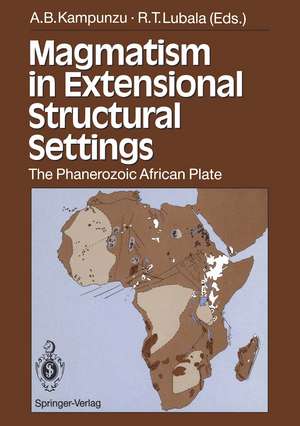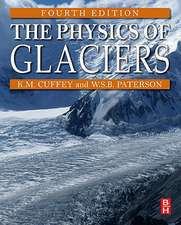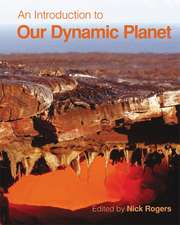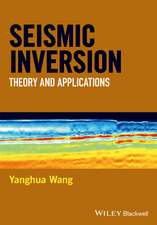Magmatism in Extensional Structural Settings: The Phanerozoic African Plate
Editat de A.B. Kampunzu, R.T. Lubalaen Limba Engleză Paperback – 22 noi 2011
Preț: 663.14 lei
Preț vechi: 780.16 lei
-15% Nou
Puncte Express: 995
Preț estimativ în valută:
126.93€ • 137.92$ • 106.69£
126.93€ • 137.92$ • 106.69£
Carte tipărită la comandă
Livrare economică 21 aprilie-05 mai
Preluare comenzi: 021 569.72.76
Specificații
ISBN-13: 9783642739682
ISBN-10: 3642739687
Pagini: 668
Ilustrații: XXVIII, 637 p.
Dimensiuni: 170 x 242 x 35 mm
Greutate: 1.05 kg
Ediția:Softcover reprint of the original 1st ed. 1991
Editura: Springer Berlin, Heidelberg
Colecția Springer
Locul publicării:Berlin, Heidelberg, Germany
ISBN-10: 3642739687
Pagini: 668
Ilustrații: XXVIII, 637 p.
Dimensiuni: 170 x 242 x 35 mm
Greutate: 1.05 kg
Ediția:Softcover reprint of the original 1st ed. 1991
Editura: Springer Berlin, Heidelberg
Colecția Springer
Locul publicării:Berlin, Heidelberg, Germany
Public țintă
ResearchDescriere
The African continent is unique in that it has escaped widespread orogenic activity after the Pan African orogenic event. Therefore, the African Plate provides the world's best example of the relationship between extensional magmatism and structural setting. This first complete and up-to-date review, written by leading scientists, discusses the evolutionary model and offers a new and reliable basis for scientists working on plate tectonics and extensional areas in other continents.
Cuprins
I. East African Rift Volcanism.- Distribution of the Main Phanerozoic African Rifts and Associated Magmatism: Introductory Notes.- 1 Introduction.- 2 The Palaeozoic African Rifts.- 3 The Mesozoic African Continental Rifts.- 3.1 Southern Africa.- 3.2 Western Africa.- 3.3 Eastern Africa.- 4 The Cainozoic African Continental Rifts.- 4.1 The East African Rift System (EARS).- 4.2 Northeastern Africa.- 4.3 West Central Africa.- 5 Summary.- Acknowledgements.- 1 The Discovery of the African Rift Geology: A Summary.- 1 Foreward.- 2 Beginnings.- 3 1880 to World War I: Geological Pioneers and Eduard Suess’ Synthesis.- 4 Post-World War I: New Reviews and Old Theories.- 5 Old Problems and New Theories.- 6 Post-1939: The New Revolution Ignores Its Predecessors.- 7 References.- 2 Phanerozoic Volcanism of Southwest Uganda: A Case for Regional K and lile Enrichment of the Lithosphere Beneath a Domed and Rifted Continental Plate.- 1 Introduction.- 2 Tectonic and Geological Setting of the Major Volcanic Areas.- 2.1 The Southern Field of Bufumbira.- 2.2 The Central Fields of Bunyaruguru (+Katunga) and Katwe-Kikorongo.- 2.3 The Northern Fields of Fort Portal and Kasekere.- 2.4 Other Volcanic Occurrences.- 3 Volcanic Style and Products.- 4 The Nature of the Volcanic Activity.- 5 Petrography.- 5.1 The Host Melts.- 5.2 Ultramafic Xenoliths.- 6 Information Provided by P, T Experiments and Mineral Chemistry: Xenoliths, Xenocrysts and Phenocrysts (OBP series).- 6.1 Olivine.- 6.2 Clinopyroxene.- 6.3 Dark Mica.- 6.4 OBP Series: Summary.- 6.5 Ores.- 7 Lower Pressure and Groundmass Assemblages.- 7.1 Melilite.- 7.2 Leucite.- 7.3 Nepheline and Kalsilite.- 7.4 Clinopyroxene.- 7.5 Phlogopite with mol Na2O + K2O>Al2O3.- 7.6 Glasses.- 7.7 Carbonatite Groundmass.- 8 Bulk Rock Chemistry.- 8.1 Major and Minor Element Chemistry.- 8.2 Trace and Rare Earth Elements.- 8.3 Sr, Nd and Pb Isotope Systematics.- 9 Summary of the Key Physical, Petrographic and Chemical Features of South West Ugandan Quaternary Volcanism.- 9.1 Physical.- 9.2 Petrographic.- 9.3 Chemical.- 10 Discussion.- Acknowledgements.- 3 Source Regions for Ultrapotassic Mafic-Ultramafic Magmatism in the Southwest Uganda Region of the African Rift: Implications from Experimental Studies.- 1 Introduction.- 2 Chemistry of the Mafic-Ultramafic Ultrapotassic Rocks of the Southwest Ugandan Area.- 3 Inferences of Experimental Studies to Source Regions.- 4 Experimental Techniques.- 5 Inferred Mantle Source Regions from Experiments on Ugandite, Katungite and Mafurite.- 6 Inferred Source for Ultrapotassic Magmas from Partial Melting Experiments of a Model Clinopyroxenite Nodule.- 7 Implications of Experiments on Magmatic Processes in Continental Rift Regions.- Acknowledgements.- 4 Magmatic Evolution and Petrogenesis in the East African Rift System.- 1 Introduction.- 2 Regional Setting of Volcanism in the East African Rift.- System.- 3 Volcanic and Structural Evolution in Eastern Africa.- 3.1 Eastern Rift.- 3.2 Western Rift.- 4 Classification of Rift Magmatic Types.- 4.1 Suite 1: Ultraalkaline/Carbonatitic Rocks.- 4.2 Suite 2: Alkaline Rocks.- 4.3 Suite 3: Transitional Rocks.- 4.4 Suite 4: Tholeiitic Rocks.- 5 The Nature of the Mantle Beneath Eastern Africa: Information from Ultramafic Xenoliths.- 6 The Nature of the Mantle Beneath Eastern Africa: Inferences from Mafic Rock Trace Element Geochemistry.- 6.1 General Remarks.- 6.2 ITE Variations Related to Basalt Composition.- 6.3 ITE Variations Related to Degree of Crustal/Lithospheric Extension.- 6.4 ITE Variations at Individual Volcanic Centres and Within Given Volcanic Subprovinces: Small-Scale Mantle Heterogeneities.- 6.5 Medium-Scale Lateral Heterogeneities in the Eastern African Mantle.- 6.6 Large-Scale Lateral Heterogeneities in the Eastern African Mantle.- 7 The Nature of the Mantle Beneath Eastern Africa: Inferences from Isotope Geochemistry.- 7.1 Nd and Sr Isotopes.- 7.2 Pb Isotopes.- 7.3 Th and Ra Isotopes.- 7.4 O and C Isotopes.- 8 Evidence for Mantle Source Enrichment and Identification of Mantle End-Members.- 9 Silicic Rocks: Fractionation, Assimilation or Anatexis?.- 9.1 Crustal Anatexis.- 9.2 Assimilation.- 9.3 Crystal Fractionation.- 10 Magma Genesis and Asthenosphere-Lithosphere Dynamics..- 10.1 Magmatism and Rift Propagation.- 10.2 Magmatism and Modality of Evolution of Rift Systems.- 11 Conclusions.- Acknowledgements.- II. West African Magmatism.- West African Magmatism: Introduction.- 1 Upper Mantle Features Beneath West Africa: Relevant Trace Element Constraints.- 2 Upper Mantle Features Beneath West Africa: Inferences from Isotopic Constraints.- 3 Discussion and Conclusion.- Acknowledgements.- 5 The Mesozoic Tholeiitic Province of Northwest Africa: A Volcanotectonic Record of the Early Opening of Central Atlantic.- 1 Introduction.- 2 Geological Setting.- 2.1 Mode of Occurrence.- 2.2 Structural Outline.- 2.3 Age of the Dolerites.- 3 Petrography and Mineralogy.- 3.1 Textures.- 3.2 Mineralogy.- 3.3 Pyroxene Chemistry.- 4 Geochemistry.- 4.1 Sampling and Analytical Procedures.- 4.2 Major Elements.- 4.3 Trace Elements.- 4.4 Geochemistry and Tectonic Setting.- 5 Petrogenesis.- 5.1 Alteration.- 5.2 Low-Pressure Fractionation.- 5.3 The Origin of the Continental Tholeiites: Mantle Source, Partial Melting, Crustal Contamination.- 6 Geodynamic Implications.- 6.1 Location of the CT Mantle Source.- 6.2 Mechanism of Continental Rifting and Breakup.- Acknowledgements.- Cretaceous and Cainozoic Magmatism of the Senegal Basin (West Afcrica): A Review.- 1 Introduction.- 2 Geological Setting.- 2.1 Geodynamic Framework.- 2.2 Structure and Stratigraphy of the Senegal Basin.- 3 Cretaceous Magmatism.- 4 Tertiary Volcanism.- 4.1 Stratigraphy and Age of Volcanism.- 4.2 Types of Occurrence and Volcanic Activities.- 4.3 Petrographic Features of the Lavas.- 5 Quaternary Volcanism.- 5.1 Stratigraphy and Age of Volcanism.- 5.2 Types of Volcanic Activities.- 5.3 Petrographic Features of the Lavas.- 6 Comparisons with Other Central Atlantic Alkaline Provinces.- 7 Conclusion.- Acknowledgements.- 7 The Canary Islands: Tectonics, Magmatism and Geodynamic Framework.- 1 Introduction.- 2 Geodynamic Evolution of the Canary Islands Area.- 3 The Crust Under the Canary Islands Region.- 4 Network of Fractures and Identity of Vertical Movements in the Canary Islands Region.- 4.1 Transoceanic and Continental Fracture Zones.- 4.2 Southern Atlas Fault.- 4.3 Faults Which have been Deduced by Volcanological, Geological and Geophysical Methods.- 4.4 Characteristics of Displacements by Faults.- 4.5 Crustal Shortening Model.- 5 Petrology and Mineralogy of the Canary Islands Igneous Rocks.- 5.1 Basal Complexes.- 5.2 Old Basaltic Series.- 5.3 Recent Series.- 6 Relationship Between the Tectonics of the Area and the Genesis and the Eruption of Magmas.- 7 Conclusions.- 8 Relationships Between Cainozoic Magmatism and Upper Mantle Heterogeneities as Exemplified by the Hoggar Volcanic Area (Central Sahara, Southern Algeria).- 1 Introduction.- 2 Nature of the Upper Mantle Beneath Hoggar.- 2.1 Heterogeneities due to Magmatism.- 2.2 Heterogeneities due to Partial Melting.- 2.3 Heterogeneities due to Metasomatism.- 3 Nature of the Basaltic Lava Sources.- 4 Conclusions.- III. Ring Complexes and Related Structures.- Ring Complexes and Related Structures: Introduction.- 1 Classification of Anorogenic Granitoids.- 2 Characteristics of the Basic Rocks Emplaced in Anorogenic Ring Complexes.- 3 Genetic Relationships of Basic Igneous Rocks and Granites in Ring Complexes.- 4 Conclusion.- Acknowledgements.- 9 The Cameroon Line: A Review.- 1 Introduction.- 2 Various Interpretations of the Cameroon Line.- 3 A New Tectonic Model of the Cameroon Line.- 4 Anorogenic Ring-Complexes.- 4.1 Mount Bana.- 4.2 NdaAli.- 4.3 Ntumbaw.- 4.4 Mayo Darle.- 4.5 Guenfalabo.- 4.6 Mboutou.- 4.7 Golda Zuelva.- 4.8 Other Intrusive Anorogenic Massifs.- 4.9 Conclusion.- 5 Volcanism.- 5.1 Pagalü.- 5.2 Säo Tomé.- 5.3 Principe.- 5.4 Bioko.- 5.5 Mount Etinde.- 5.6 Mount Cameroon.- 5.7 Kumba Graben.- 5.8 Rumpi Hills.- 5.9 Tombel Plain.- 5.10 Manengouba.- 5.11 Bamoun Plateau.- 5.12 Mounts Bambouto.- 5.13 Oku Massif.- 5.14 Garoua Upper Benue Valley.- 5.15 Kapsiki Plateau.- 5.16 Other Volcanic Regions in Cameroon.- 5.17 Conclusion.- 6 Discussion About the Nature of the Cameroon Line.- Acknowledgements.- 10 Palaeozoic Magmatism in the Air Massif, Niger.- 1 Introduction.- 2 History of Geological Research.- 3 Geological Setting.- 3.1 The Precambrian Basement.- 3.2 Palaeozoic Subvolcanic Ring-Structures.- 3.3 Volcanism.- 4 Structure.- 4.1 Gravity Data.- 4.2 Remote Sensing.- 4.3 Autocorrelation Analysis.- 4.4 Interpretation.- 5 Ring-Complexes of Taghouaji Type.- 5.1 The Taghouaji Ring-Complex.- 5.2 Conclusion.- 6 Ring-Complexes of Goundai Type.- 6.1 Goundai.- 6.2 Bilet.- 6.3 Relationship Between the Goundai-Type and the Uranium Deposits of Arlit.- 7 Ring Complexes of Ofoud Type.- 8 Discussion and Conclusions.- 8.1 Age Relationships.- 8.2 Hypotheses on the Origin of the Lineament.- 11 Ring-Complexes of Ofoud-Type in Air, Niger: A new Anorogenic-Type Anorthosite Association.- 1 Introduction.- 2 Field Relationships, Petrology and Mineralogy of the Complexes.- 2.1 Bous.- 2.2 Tamgak-Tchinadene.- 2.3 Ofoud.- 2.4 Meugueur-Meugueur.- 2.5 Taguei.- 2.6 Abontorok.- 2.7 Iskou.- 3 Geochemistry.- 3.1 Major Elements.- 3.2 K-Rb Data.- 3.3 REE Distributions.- 4 Strontium Isotopie Composition.- 4.1 Basic Rocks.- 4.2 Salic Rocks.- 5 Discussion and Conclusions.- 5.1 Summary of the Main Characteristics of Ofoud-Type Ring-Complexes.- 5.2 Comparison of Ofoud-Type Ring-Complexes with Other Anorthosite Occurrences.- 5.3 Comparison of the Ofoud-Type with Other Anorogenic Ring-Complexes.- Acknowledgements.- 12 The Chilwa Alkaline Igneous Province of Malawi: A Review.- 1 Introduction.- 2 The Chilwa Province.- 2.1 Age of the Province.- 2.2 Igneous Activity and Rift Tectonics.- 3 The Earliest Work on the Chilwa Alkaline Province-Dixey, Campbell Smith and Bisset.- 4 The 1950’s and 1960’s and the Work of the Geological Survey.- 5 Work Since 1969.- 5.1 Fenitization.- 5.2 Mineralogy.- 5.3 Petrochemistry.- 5.4 Petrogenesis.- Acknowledgements.- 13 Magmatism and Mineralization Associated with Phanerozoic Anorogenic Plutonic Complexes of the African Plate.- 1 Introduction.- 2 Oversaturated Alkaline Complexes with Granites and Syenites.- 2.1 Introduction.- 2.2 Structure and Petrology.- 2.3 Problems of Classification.- 2.4 Age and Petrological Variations of the Different Provinces.- 2.5 Major Element Chemistry of the Oversaturated Ring- Complexes.- 2.6 Ttace Element Chemistry of the Oversaturated Ring- Complexes.- 2.7 The Effect of Late-Stage Fluids.- 2.8 The Nature of the Late-Stage Fluids.- 2.9 Geochemistry of the Alteration Processes.- 2.10 Mineralization and Economic Aspects of the Over- saturated Ring-Complexes.- 3 Mixed Saturated and Undersaturated Alkaline Provinces with Carbonatites.- 3.1 Introduction.- 3.2 Structure and Petrology.- 3.3 Age and Variations of the Different Provinces.- 3.4 Major Element Chemistry of Carbonatites and Related Rocks.- 3.5 Trace Element Chemistry of Carbonatites and Related Rocks.- 3.6 The Effects of Late-Stage Fluids: Fenitization and Related Processes.- 3.7 Mineralization and Economic Aspects of Carbonatites..- 3.8 Mineralization and Economic Aspects of Oversaturated Ring-Complexes in Mixed Provinces.- 4 Undersaturated Complexes with Carbonatites.- 4.1 Introduction.- 4.2 Age and Petrological Variations of the Provinces.- 4.3 Mineralization.- 5 Conclusions.- 5.1 Introduction.- 5.2 Summary Comparisons Between the Oversaturated and Undersaturated Mineralization.- 5.3 Summary Contrasts Between the Oversaturated and Undersaturated Mineralization.- 5.4 Final Comment.- Acknowledgements.- IV. African Kimberlites.- African Kimberlites: Introduction.- 1 Introduction.- 2 Southern Africa.- 3 Central Africa.- 4 Western Africa.- 5 Eastern Africa.- 6 Conclusions.- Acknowledgements.- 14 Southern African Kimberlites and Their Xenoliths.- 1 Kimberlites.- 1.1 History and Distribution.- 1.2 Kimberlite Morphology and Petrography.- 1.3 Kimberlite Geochemistry.- 2 Peridotite Xenoliths.- 2.1 Low-Temperature Peridotites.- 2.2 High-Temperature Peridotites.- 2.3 Modally Metasomatized Peridotites.- 2.4 Pyroxenites.- 2.5 MARID Nodules.- 3 Eclogite and Granulite Xenoliths.- 3.1 Off-Craton and Craton Margin Eclogite Xenoliths.- 3.2 Central Craton Eclogite Xenoliths.- 4 Megacrysts.- 4.1 Cr-rich Megacrysts.- 4.2 The Granny Smith Diopside Association.- 4.3 Cr-poor Megacrysts.- 5 Diamonds and Their Mineral Inclusions.- 5.1 Diamond Characteristics.- 5.2 Inclusion Characteristics.- 5.3 Isotopic Model Ages.- 6 Kimberlite and Diamond Indicator Minerals.- 7 Synthesis.- Acknowledgements.- 15 The Kimberlites of Central Africa: A Review.- 1 Introduction.- 2 Geological Situation and Tectonic Setting.- 2.1 The Kimberlites of Zaire.- 2.2 The Kimberlites of Angola.- 3 Petrography and Mineralogy.- 3.1 Petrography of the Kimberlites.- 3.2 Mantle Xenoliths and Megacryst Suite.- 3.3 Diamonds.- 4 Geochemistry.- 4.1 Major Elements.- 4.2 Trace Elements.- 4.3 Sr, Nd and Pb Isotopie Composition.- 4.4 C, O and N Isotopie Compositions at Mbuji-Mayi.- 5 Conclusions.- Acknowledgements.- References (compiled by A.B. Kampunzu).- Geographical Index (compiled by R.T. Lubala).













